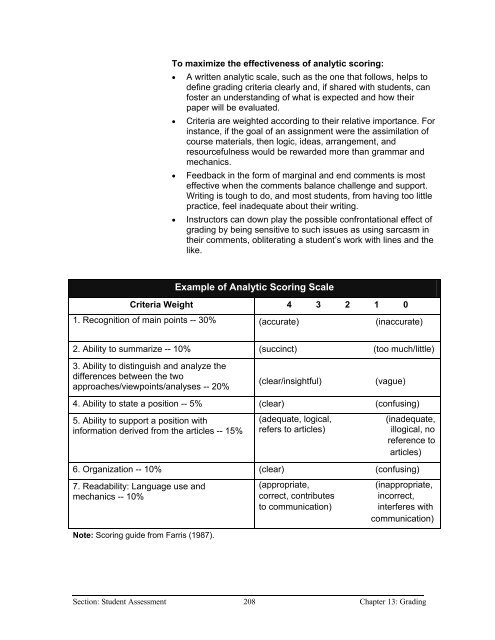Chapter 9 - Instructional Media: Chalkboards to Video - CGISS
Chapter 9 - Instructional Media: Chalkboards to Video - CGISS
Chapter 9 - Instructional Media: Chalkboards to Video - CGISS
Create successful ePaper yourself
Turn your PDF publications into a flip-book with our unique Google optimized e-Paper software.
To maximize the effectiveness of analytic scoring:<br />
• A written analytic scale, such as the one that follows, helps <strong>to</strong><br />
define grading criteria clearly and, if shared with students, can<br />
foster an understanding of what is expected and how their<br />
paper will be evaluated.<br />
• Criteria are weighted according <strong>to</strong> their relative importance. For<br />
instance, if the goal of an assignment were the assimilation of<br />
course materials, then logic, ideas, arrangement, and<br />
resourcefulness would be rewarded more than grammar and<br />
mechanics.<br />
• Feedback in the form of marginal and end comments is most<br />
effective when the comments balance challenge and support.<br />
Writing is <strong>to</strong>ugh <strong>to</strong> do, and most students, from having <strong>to</strong>o little<br />
practice, feel inadequate about their writing.<br />
• Instruc<strong>to</strong>rs can down play the possible confrontational effect of<br />
grading by being sensitive <strong>to</strong> such issues as using sarcasm in<br />
their comments, obliterating a student’s work with lines and the<br />
like.<br />
Example of Analytic Scoring Scale<br />
Criteria Weight 4 3 2 1 0<br />
1. Recognition of main points -- 30% (accurate) (inaccurate)<br />
2. Ability <strong>to</strong> summarize -- 10% (succinct) (<strong>to</strong>o much/little)<br />
3. Ability <strong>to</strong> distinguish and analyze the<br />
differences between the two<br />
approaches/viewpoints/analyses -- 20%<br />
(clear/insightful)<br />
(vague)<br />
4. Ability <strong>to</strong> state a position -- 5% (clear) (confusing)<br />
5. Ability <strong>to</strong> support a position with<br />
information derived from the articles -- 15%<br />
(adequate, logical,<br />
refers <strong>to</strong> articles)<br />
(inadequate,<br />
illogical, no<br />
reference <strong>to</strong><br />
articles)<br />
6. Organization -- 10% (clear) (confusing)<br />
7. Readability: Language use and<br />
mechanics -- 10%<br />
Note: Scoring guide from Farris (1987).<br />
(appropriate,<br />
correct, contributes<br />
<strong>to</strong> communication)<br />
(inappropriate,<br />
incorrect,<br />
interferes with<br />
communication)<br />
Section: Student Assessment 208 <strong>Chapter</strong> 13: Grading
















